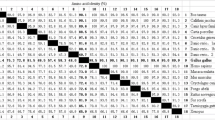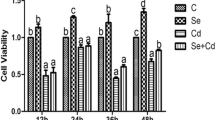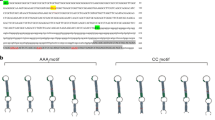Abstract
The 15-kDa selenoprotein (Sep15) is a thioredoxin-like protein. The expression of Sep15 is regulated by dietary selenium (Se) and plays important roles in mammals. However, the structure and function of chicken Sep15 and its response to Se are still unclear. In the present study, we replicated the chicken Se deficiency models and Sep15 deficiency models in splenocytes. Then, the homology, structure analysis, and levels of Sep15 were analyzed. In addition, the oxidative stress levels were examined in Sep15 deficiency splenocytes. The results indicated that chicken Sep15 preserved high similarity with that of other 14 animals in the coding nucleotide sequences (CDS) and deduced amino acid sequence, which suggested that chicken Sep15 may be derived from the same ancestor with other animals. The predicted structure and function showed that chicken Sep15 preserved the conserved thioredoxin-like fold CxU, which suggested an antioxidative function. Chicken Sep15 was also decreased by Se deficiency in immune organs (P < 0.05). In addition, Sep15 deficiency induced the occurrence of higher oxidative stress and enhanced the sensitivity of cells to H2O2 (P < 0.05). So the in vitro study further verified its antioxidative function. Thus, similar to its mammal homolog, chicken Sep15 preserves the typical characteristic of selenoprotein and may play some roles in the redox regulation.









Similar content being viewed by others
References
Rederstorff M, Krol A, Lescure A (2006) Understanding the importance of selenium and selenoproteins in muscle function. Cell Mol Life Sci 63:52–59
Bellinger FP, Raman AV, Reeves MA, Berry MJ (2009) Regulation and function of selenoproteins in human disease. Biochem J 422:11–22
Avanzo JL, de Mendonca CX Jr, Pugine SM, de Cerqueira Cesar M (2001) Effect of vitamin E and selenium on resistance to oxidative stress in chicken superficial pectoralis muscle. Comp Biochem Physiol C Toxicol Pharmacol 129:163–173
Pappas AC, Zoidis E, Surai PF, Zervas G (2008) Selenoproteins and maternal nutrition. Comp Biochem Physiol B Biochem Mol Biol 151:361–372
Moghadaszadeh B, Beggs AH (2006) Selenoproteins and their impact on human health through diverse physiological pathways. Physiology 21:307–315
Dikiy A, Novoselov SV, Fomenko DE et al (2007) SelT, SelW, SelH, and Rdx12 genomics and molecular insights into the functions. Biochemistry 46:6871–6882
Gladyshev VN, Jeang KT, Wootton JC, Hatfield DL (1998) A new human selenium-containing protein. Purification, characterization, and cDNA sequence. J Biol Chem 273:8910–8915
Kumaraswamy E, Malykh A, Korotkov KV et al (2000) Structure-expression relationships of the 15-kDa selenoprotein gene. Possible role of the protein in cancer etiology. J Biol Chem 275:35540–35547
Kasaikina MV, Fomenko DE, Labunskyy VM et al (2011) Roles of the 15-kDa selenoprotein (Sep15) in redox homeostasis and cataract development revealed by the analysis of Sep 15 knockout mice. J Biol Chem 286:33203–33212
Mariotti M, Ridge PG, Zhang Y et al (2012) Composition and evolution of the vertebrate and mammalian selenoproteomes. PLoS One 7:e33066
Yu D, Zhang ZW, Yao HD, Li S, Xu SW (2014) Antioxidative role of selenoprotein W in oxidant-induced chicken splenic lymphocyte death. Biometals 27:277–291
Peirson SN, Butler JN, Foster RG (2003) Experimental validation of novel and conventional approaches to quantitative real-time PCR data analysis. Nucleic Acids Res 31:e73
Livak KJ, Schmittgen TD (2001) Analysis of relative gene expression data using real-time quantitative PCR and the 2(-Delta Delta C(T)) Method. Methods 25:402–408
Esterbauer H, Cheeseman KH (1990) Determination of aldehydic lipid peroxidation products: malonaldehyde and 4-hydroxynonenal. Methods Enzymol 186:407–421
Bradford MM (1976) A rapid and sensitive method for the quantitation of microgram quantities of protein utilizing the principle of protein-dye binding. Anal Biochem 72:248–254
Chapple CE, Guigo R, Krol A (2009) SECISaln, a web-based tool for the creation of structure-based alignments of eukaryotic SECIS elements. Bioinformatics 25:674–675
Ferguson AD, Labunskyy VM, Fomenko DE et al (2006) NMR structures of the selenoproteins Sep15 and SelM reveal redox activity of a new thioredoxin-like family. J Biol Chem 281:3536–3543
Hawkes WC, Wang TT, Alkan Z, Richter BD, Dawson K (2009) Selenoprotein W modulates control of cell cycle entry. Biol Trace Elem Res 131:229–244
Loflin J, Lopez N, Whanger PD, Kioussi C (2006) Selenoprotein W during development and oxidative stress. J Inorg Biochem 100:1679–1684
Yao HD, Wu Q, Zhang ZW et al (2013) Selenoprotein W serves as an antioxidant in chicken myoblasts. Biochim Biophys Acta 1830:3112–3120
Wang X-L, Yang C-P, Xu K, Qin O-J (2010) Selenoprotein W depletion in vitro might indicate that its main function is not as an antioxidative enzyme. Biochem Mosc 75:201–207
Han YH, Zhang ZW, Su J et al (2012) Effects of chicken selenoprotein W on H2O2-induced apoptosis in CHO-K1 cells. Biol Trace Elem Res 147:395–402
Sengupta A, Carlson BA, Labunskyy VM, Gladyshev VN, Hatfield DL (2009) Selenoprotein T deficiency alters cell adhesion and elevates selenoprotein W expression in murine fibroblast cells. Biochem Cell Biol 87:953–961
Panee J, Stoytcheva ZR, Liu W, Berry MJ (2007) Selenoprotein H is a redox-sensing high mobility group family DNA-binding protein that up-regulates genes involved in glutathione synthesis and phase II detoxification. J Biol Chem 282:23759–23765
Hwang DY, Sin JS, Kim MS et al (2008) Overexpression of human selenoprotein M differentially regulates the concentrations of antioxidants and H2O2, the activity of antioxidant enzymes, and the composition of white blood cells in a transgenic rat. Int J Mol Med 21:169–179
Yu D, Li JL, Zhang JL, Gao XJ, Xu S (2011) Effects of dietary selenium on selenoprotein W gene expression in the chicken immune organs. Biol Trace Elem Res 144:678–687
Yao HD, Wu Q, Zhang ZW et al (2013) Gene expression of endoplasmic reticulum resident selenoproteins correlates with apoptosis in various muscles of se-deficient chicks. J Nutr 143:613–619
Xu M, Sun D, Li J, Xu S (2011) Monoclonal antibodies against avian selenoprotein W. Hybridoma 30:563–566
Wu Q, Yao HD, Zhang ZW et al (2012) Possible correlation between selenoprotein W and myogenic regulatory factors in chicken embryonic myoblasts. Biol Trace Elem Res 150:166–172
Wang R, Sun B, Zhang Z, Li S, Xu S (2011) Dietary selenium influences pancreatic tissue levels of selenoprotein W in chickens. J Inorg Biochem 105:1156–1160
Sun B, Wang R, Li J, Jiang Z, Xu S (2011) Dietary selenium affects selenoprotein W gene expression in the liver of chicken. Biol Trace Elem Res 143:1516–1523
Ruan H, Zhang Z, Wu Q et al (2012) Selenium regulates gene expression of selenoprotein W in chicken skeletal muscle system. Biol Trace Elem Res 145:59–65
Gao X, Xing H, Li S et al (2012) Selenium regulates gene expression of selenoprotein W in chicken gastrointestinal tract. Biol Trace Elem Res 145:181–188
Irons R, Tsuji PA, Carlson BA et al (2010) Deficiency in the 15-kDa selenoprotein inhibits tumorigenicity and metastasis of colon cancer cells. Cancer Prev Res 3:630–639
Hawkes WC, Alkan Z (2010) Regulation of redox signaling by selenoproteins. Biol Trace Elem Res 134:235–251
Kryukov GV, Castellano S, Novoselov SV et al (2003) Characterization of mammalian selenoproteomes. Science 300:1439–1443
Sunde RA, Raines AM, Barnes KM, Evenson JK (2009) Selenium status highly regulates selenoprotein mRNA levels for only a subset of the selenoproteins in the selenoproteome. Biosci Rep 29:329–338
Holben DH, Smith AM (1999) The diverse role of selenium within selenoproteins. J Am Diet Assoc 99:836–843
Fatmi W, Kechrid Z, Naziroglu M, Flores-Arce M (2013) Selenium supplementation modulates zinc levels and antioxidant values in blood and tissues of diabetic rats fed zinc-deficient diet. Biol Trace Elem Res 152:243–250
Zhang JL, Li JL, Huang XD et al (2012) Dietary selenium regulation of transcript abundance of selenoprotein N and selenoprotein W in chicken muscle tissues. Biometals 25:297–307
Huang JQ, Li DL, Zhao H et al (2011) The selenium deficiency disease exudative diathesis in chicks is associated with downregulation of seven common selenoprotein genes in liver and muscle. J Nutr 141:1605–1610
Acknowledgments
This research is supported by The Project of Harbin Normal University Research Fund (11XY-03), The Key Laboratory of Intelligence Education and of Information Engineering in Heilongjiang.
Conflict of interest
The authors declare no conflict of interest.
Author information
Authors and Affiliations
Corresponding author
Additional information
All of the authors have read the manuscript and agreed to submit it in its current form for consideration for publication in the Biological trace element research.
Rights and permissions
About this article
Cite this article
Sun, H., Deng, T. & Fu, J. Chicken 15-kDa Selenoprotein Plays Important Antioxidative Function in Splenocytes. Biol Trace Elem Res 161, 288–296 (2014). https://doi.org/10.1007/s12011-014-0126-1
Received:
Accepted:
Published:
Issue Date:
DOI: https://doi.org/10.1007/s12011-014-0126-1




